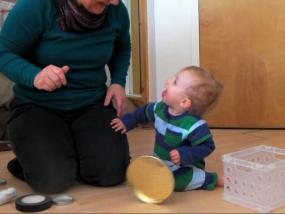Why Blake and Lou Move Like Tops

Young children often imitate an action that they see. This action could be an early form of representation; that is, making a symbol that "stands for" a referent that happened in the immediate past. By imitating the event, the child in a sense "puts a handle" on the event so that she can mentally "grasp" it. Using two short clips, we have added more granularity to these metaphors. The text first describes what occurred, and then in italics presents our interpretation of what the child and the teacher might have been thinking, not literally as explicit thoughts, but rather as some intuitive level of their intentions.
First segment: Blake imitates the spinning top, 00:00 to 00:37
Your download will include a detailed analysis of this first segment.
We can offer several interpretations of the rocking movements that Blake makes.
A schema:A gesture that indicates what Blake is abstracting from the flow of his immediate experience. He is producing what he sees. By producing the event that he sees, the event enters his consciousness more as an object; that is, he is encoding or objectifying his experience. Once a slice of a macro-experience has been represented in gesture, it has boundaries; it is sort of contained. The child can think of it as an intact "thing" that has a name, is linked to memories of fun, can be reproduced across a range of physical objects, and so forth. The spinning action becomes a mental script or schema that can be used in a multitude of ways.
A sharing:A gesture that mediates a feeling of sharing an experience with an adult. The rocking lets the adult know that it is the spinning that the child finds interesting. The gesture represents the action of the lid. The main motive for the rocking is to communicate a thought to the teacher. In the previous interpretation, the child is transforming a sight into an experience (objectification), but is not as sensitive to communicating to an audience.
A sequence:A gesture that is part of a game that has no more meaning than "after we do this, we do that." The teacher spins the lid, the child looks to the teacher, and they both start to rock. This sequence, established in previous rounds, is repeated simply because both players know the sequence. The repetition serves to support the good feeling of being together.
Second segment: Lou imitates the spinning top 00:37 - 01:43
There are many interesting encounters that take place during this second segment, but in regards to our interest in imitation, take particular note of Lou, in brown corduroy overalls, spinning the lid to a cookie tin. Around 01:17, he bends and straightens his upper body while looking at the spinning lid. He does this even more immediately at 01:37. Do you think Lou is creating a schema, sharing his experience, or playing a sequence game? Or perhaps you have even a fourth interpretation of why Lou is moving up and down.
Run Time: 1 minutes 48 seconds
